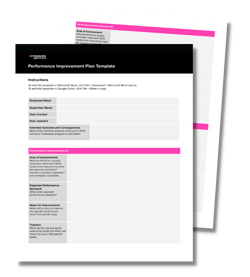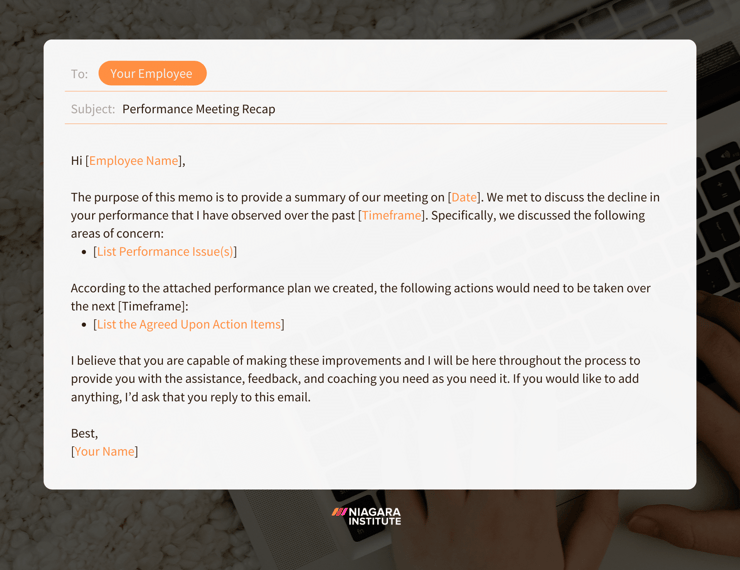4 min read
The Do’s and Don’ts of Performance Conversations
A performance conversation, which you may also hear referred to as a performance discussion or dialogue, happens between an employee and their direct...
4 min read
 Michelle Bennett
:
Jul 13, 2023 5:00:00 AM
Michelle Bennett
:
Jul 13, 2023 5:00:00 AM

As someone who manages people, it is your duty and responsibility to address poor performance as soon as you possibly can, no matter how nervous doing so might make you feel. If you don’t, you not only do your employee a great disservice, you may even jeopardize your entire team’s performance.
As the widely popular author and speaker Dr. Brené Brown once said: “Brave leaders are never quiet about hard things. It’s about excavating the unsaid, the stuff that gets in the way of good work.”
One way to make it easier to address poor performance with employees is to have a step-by-step process that you can follow. While your organization may already have a formalized and documented process for you to use, if they do not, here are the general steps you should take to address and discuss poor performance.
Before discussing poor performance, you need to identify the issue and put together your observations and examples that back up why it's an issue. The key here is to be as specific as possible. If you can’t fully explain the performance issue, why it's an issue, and how you know it's an issue, then you’re only going to confuse and frustrate your employee.
Once you know what issue is causing an employee to perform poorly, you need to understand what brought them to that place. While it very well might be something the employee has done wrong, there’s a chance that, upon reflection, you realize that you didn’t set them up for success. To figure out which it is, ask yourself and possibly your employee the following questions:
If you determine that your employee is responsible for their lackluster performance, then the next step is to seek out the perspectives and insights of others they work with directly. For example, suppose there’s another employee or leader who they work with day in and day out. In that case, that person likely has personal experience and knowledge of the situation that you don’t. By seeking that information out, you’ll better understand the performance issue(s) at hand, which will help you when it comes time to sit down and discuss it with them.
At this point, you have a good sense of what is going on in terms of your employee’s performance. But before you go ahead and discuss it with them, it’s a good idea to share your concerns with HR. Not only might they provide you with documentation and tools you can use going forward, but they may also be a source of valuable guidance and much-needed support.
The next step will be to set up a time with your employee to discuss your concerns about their poor performance. You do not want to wait too long to have this one-on-one meeting; otherwise, you risk all that information you collected becoming outdated. Also, you want this meeting to take place in private between just you and your employee. The goal here is to have an open and honest two-way conversation about the performance issue(s) you are seeing and to hear their perspectives.
 As soon as you’ve identified the issues and listened to what your employee had to say in your one-on-one meeting, move on to creating an actionable performance improvement plan together. The great thing about collaborating on this document is that it shows an employee you care and are willing to support them and feeds their sense of optimism, accountability, and motivation. In fact, according to Gartner, this type of forward-looking performance review can increase employee performance by up to 13%.
As soon as you’ve identified the issues and listened to what your employee had to say in your one-on-one meeting, move on to creating an actionable performance improvement plan together. The great thing about collaborating on this document is that it shows an employee you care and are willing to support them and feeds their sense of optimism, accountability, and motivation. In fact, according to Gartner, this type of forward-looking performance review can increase employee performance by up to 13%.
After the meeting, you’ll want to send an email to the employee and possibly HR, which documents what you discussed and the timeline you assigned, as well as includes the completed performance improvement plan. To give you an idea of what that should look like, here is an example of a follow-up email you can use and make your own the next time you have to discuss poor performance.
Hi [Employee Name],
The purpose of this memo is to provide a summary of our meeting on [Date]. We met to discuss the decline in your performance that I have observed over the past [Timeframe]. Specifically, we discussed the following areas of concern:
According to the attached performance plan we created, the following actions would need to be taken over the next [Timeframe]:
I believe that you are capable of making these improvements and I will be here throughout the process to provide you with the assistance, feedback, and coaching you need as you need it. If you would like to add anything, I’d ask that you reply to this email.
Best,
[Your Name]

Depending on what is causing your employee to perform poorly and what improvements need to be made, it could take weeks or even months for them to get to the place that you need them to be. While they have to be willing to make the necessary changes themselves, that doesn’t mean they need to do it entirely alone. In fact, your active participation in the process will go a long way. So, be sure to regularly check in on them, monitor their progress, step in when course corrections need to be made, and provide them with the coaching, feedback, and support they need.
The final step in addressing poor performance is re-evaluating. Ask yourself, did your employee make the improvements outlined in the plan you created together? Are you satisfied with their progress? Were they engaged in the process, or did it feel like a fight to get them to care? If the answer to these types of questions is no, then you will likely need to escalate the situation with the help of your HR team.

4 min read
A performance conversation, which you may also hear referred to as a performance discussion or dialogue, happens between an employee and their direct...
.png)
7 min read
Many leaders have trepidations when it comes to delivering employee feedback. A survey of over 7,000 people uncovered that 44% of managers find...

5 min read
The term performance management may bring a shiver down your spine, as it did mine when I first started in management. Many managers, myself...